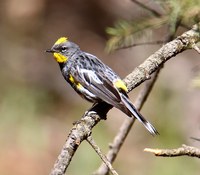Home to ponderosa, Douglas fir, and lodgepole pines, Genesee Mountain Park is a haven to birds and a hot spot for hopeful watchers to see a range of feathered friends from mountain chickadee to western tanager. Due to its proximity to Denver, the area is a local favorite for escaping the city during the week and observing some of Colorado's more colorful residents.
CMC Press's newest title, The Best Front Range Bird Hikes, is the first guide of its kind to combine the hobby of birding with hiking Colorado's scenic trails. With over 175 species of birds across 30 trails in the Front Range, this title is sure to keep even the most avid birder busy.
Enjoy a sample chapter below!
**************************************************************************************************
From The Best Front Range Bird Hikes
By Norm Lewis
FEATURED BIRDS: Williamson’s sapsucker; tree and violet-green swallows; pygmy, white-breasted, and red-breasted nuthatches; brown creeper; mountain chickadee; mountain and western bluebirds; chipping sparrow; western tanager; and red crossbill
COMMENT: Genesee Mountain Park is a Denver Mountain Park situated in Jefferson County. It is among the easiest of our hikes but also one of the most productive. It can be good at any season, but is best during summer nesting season and migration in late summer/early fall, when mountain species are descending from higher elevations.
GETTING THERE: Travel up I-70 from the Denver area west into the foothills and take the Genesee exit. At the top of the exit ramp, you may see the resident bison herd in the meadows on either side of I-70. After looking at the bison, turn left, and follow the road as it crosses I-70. After crossing over I-70, you will come to an intersection. Turn right and follow Genesee Mountain Road as it winds its way up to the park. Soon you will arrive at the main parking lot. The road continues up the mountain, but is gated at the picnic area, so park and begin the hike.
THE ROUTE: Begin the hike at the large parking lot. After walking north out of the parking lot, note the broken tree to the west of the picnic area. It is perforated with woodpecker holes, which serve as nesting cavities for pygmy nuthatches, tree swallows, and other birds. It has a small plaque designating it as a “wildlife tree.” The picnic area has pygmy nuthatches—listen for their incessant peeping. Williamson’s sapsucker is also frequently seen here, as well as hairy woodpecker and dark-eyed junco. Continue hiking up the paved road, where you may find all the nuthatches and brown creepers working the ponderosa pines. After about a hundred yards, you will come to a small open prairie area on the left. This and other similar open areas are good for bluebirds. Broad-tailed hummingbirds abound among the scattered blooming bushes in late summer.
Continue following the road as the pavement ends and the dirt/gravel portion begins. Look among the variety of conifers for dark-eyed juncos, red crossbills, Hammond’s flycatcher, chipping sparrow, and mountain and western bluebirds (summer). Listen for the “Quick! Three beers!” song of the olive-sided flycatcher. The road circles the mountain, taking a corkscrew route up to the top. As you round the north end of the circle, you will enter an area that is favored by western tanagers as Mount Evans comes into view. A little farther up the road is the upper parking area. Check the cavities in the ponderosa pines for nesting bluebirds, and this is another area frequented by Williamson’s sapsucker.
Upon reaching the parking area, proceed up the path at the far end of the lot to the top of Genesee Mountain. The top is marked by a flagpole that was erected by the Daughters of the American Revolution over a century ago. There is a small open area at the summit. At the end opposite the flagpole is a dead ponderosa pine, which is riddled with woodpecker holes. This is the “condo tree” and it hosts nesting swallows, nuthatches, and woodpeckers. Rock wrens can sometimes be found among the small rock outcroppings in this area.
You can take the road back down or descend via the Genesee Mountain Trail, found midway along the parking area. In the open woodlands along this trail many species are found, including western bluebird, Williamson’s sapsucker, brown creeper, all three nuthatches, northern flicker, American robin, broad-tailed hummingbird (late summer), and yellow-rumped warbler (late summer). Listen for the raspy up-and-down song of the plumbeous vireo and scan the sky for a soaring red-tailed hawk or turkey vulture. In this type of habitat, listen for subtle pecking sounds, which can lead you to nuthatches or woodpeckers (Williamson’s and rednaped sapsuckers, downy or hairy woodpeckers, and northern flicker).
Upon reaching the road, take a short walk around the group picnic pavilion. Williamson’s sapsuckers are found here and Cassin’s finches sing from the tops of the ponderosas. In the open field adjacent to the pavilion, look for both bluebirds, chipping sparrow, American robin, and dark-eyed junco.
***
If you'd like to learn more about birding and hiking in the Front Range, you can order The Best Front Range Bird Hikes here.
 CMC Press
CMC Press

Add a comment
Log in to add comments.